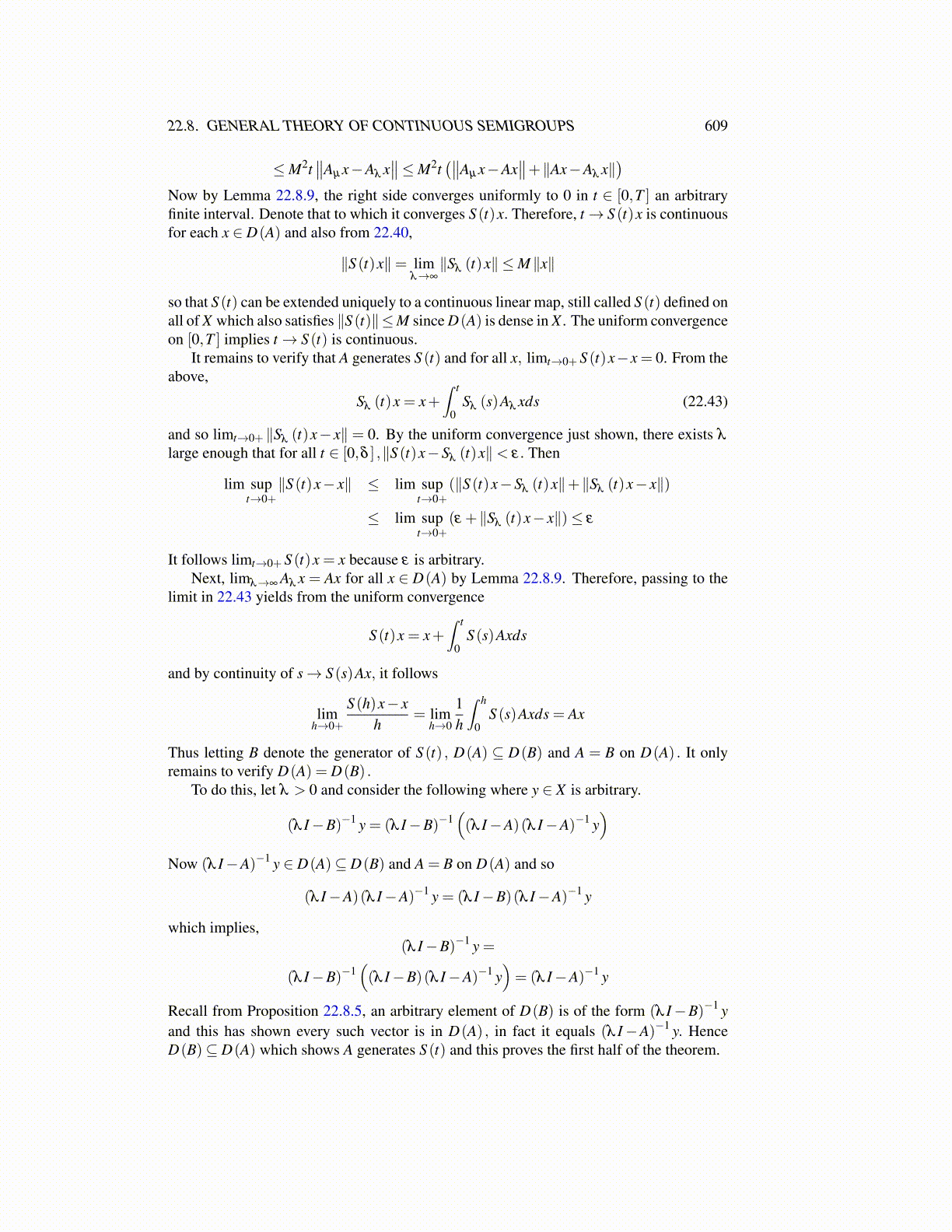
22.8. GENERAL THEORY OF CONTINUOUS SEMIGROUPS 609
≤M2t∥∥Aµ x−Aλ x
∥∥≤M2t(∥∥Aµ x−Ax
∥∥+∥Ax−Aλ x∥)
Now by Lemma 22.8.9, the right side converges uniformly to 0 in t ∈ [0,T ] an arbitraryfinite interval. Denote that to which it converges S (t)x. Therefore, t→ S (t)x is continuousfor each x ∈ D(A) and also from 22.40,
∥S (t)x∥= limλ→∞
∥Sλ (t)x∥ ≤M ∥x∥
so that S (t) can be extended uniquely to a continuous linear map, still called S (t) defined onall of X which also satisfies ∥S (t)∥≤M since D(A) is dense in X . The uniform convergenceon [0,T ] implies t→ S (t) is continuous.
It remains to verify that A generates S (t) and for all x, limt→0+ S (t)x−x = 0. From theabove,
Sλ (t)x = x+∫ t
0Sλ (s)Aλ xds (22.43)
and so limt→0+ ∥Sλ (t)x− x∥ = 0. By the uniform convergence just shown, there exists λ
large enough that for all t ∈ [0,δ ] ,∥S (t)x−Sλ (t)x∥< ε. Then
lim supt→0+
∥S (t)x− x∥ ≤ lim supt→0+
(∥S (t)x−Sλ (t)x∥+∥Sλ (t)x− x∥)
≤ lim supt→0+
(ε +∥Sλ (t)x− x∥)≤ ε
It follows limt→0+ S (t)x = x because ε is arbitrary.Next, limλ→∞ Aλ x = Ax for all x ∈ D(A) by Lemma 22.8.9. Therefore, passing to the
limit in 22.43 yields from the uniform convergence
S (t)x = x+∫ t
0S (s)Axds
and by continuity of s→ S (s)Ax, it follows
limh→0+
S (h)x− xh
= limh→0
1h
∫ h
0S (s)Axds = Ax
Thus letting B denote the generator of S (t) , D(A) ⊆ D(B) and A = B on D(A) . It onlyremains to verify D(A) = D(B) .
To do this, let λ > 0 and consider the following where y ∈ X is arbitrary.
(λ I−B)−1 y = (λ I−B)−1((λ I−A)(λ I−A)−1 y
)Now (λ I−A)−1 y ∈ D(A)⊆ D(B) and A = B on D(A) and so
(λ I−A)(λ I−A)−1 y = (λ I−B)(λ I−A)−1 y
which implies,(λ I−B)−1 y =
(λ I−B)−1((λ I−B)(λ I−A)−1 y
)= (λ I−A)−1 y
Recall from Proposition 22.8.5, an arbitrary element of D(B) is of the form (λ I−B)−1 yand this has shown every such vector is in D(A) , in fact it equals (λ I−A)−1 y. HenceD(B)⊆ D(A) which shows A generates S (t) and this proves the first half of the theorem.